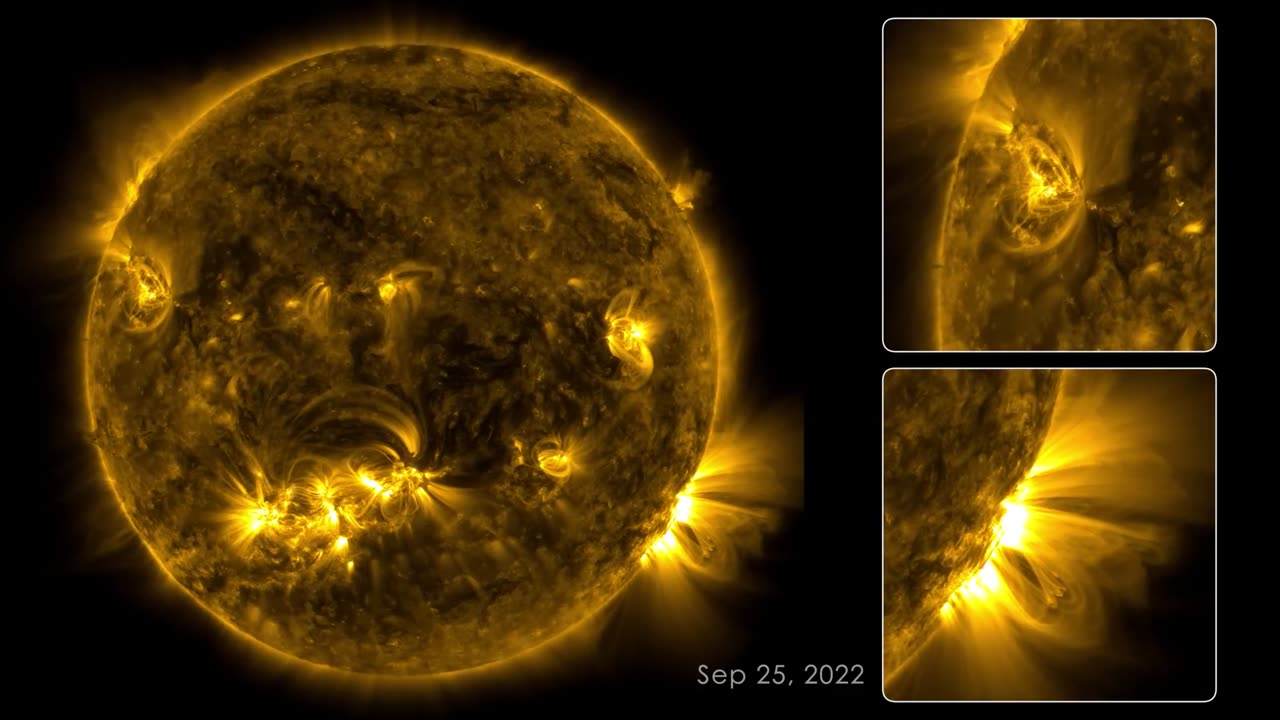Premium Only Content

133 Days on the Sun
This record traces solar activity from August 12 to December 22, 2022, as captured by NASA's Solar Dynamics Observatory (SDO). Positioned in Earth's orbit, the SDO has consistently captured the Sun's imagery in 4K x 4K resolution for nearly 13 years. This data has yielded numerous novel insights into the Sun's dynamics and its influence on the solar system. Equipped with a trio of instruments, the SDO captures a snapshot of the Sun every 0.75 seconds. Notably, the Atmospheric Imaging Assembly (AIA) instrument captures images every 12 seconds across ten different wavelengths of light. This 133-day time-lapse showcases images taken at a 17.1 nanometer extreme-ultraviolet wavelength, revealing the Sun's outermost atmospheric layer, the corona. By compiling images taken 108 seconds apart, the footage condenses 133 days (approximately four months) of solar observations into a concise 59-minute presentation.
The video exhibits bright active regions moving across the Sun's surface as it rotates. The Sun completes a rotation roughly every 27 days. Above these bright regions, loops of magnetic fields confine hot, radiant plasma. These luminous areas also serve as sources for solar flares, appearing as brilliant flashes when magnetic fields reconnect in a process known as magnetic reconnection. While the SDO maintains continuous focus on the Sun, there have been instances where it missed certain events. Dark frames in the video arise from Earth or the Moon passing between the spacecraft and the Sun. Other interruptions result from instrument downtime or data errors. Remarkably, the SDO transmits 1.4 terabytes of data to the ground daily. Off-center sun images were captured during SDO's instrument calibration.
Looking ahead, both the SDO and other NASA missions will continue monitoring the Sun, providing deeper insights into our cosmic surroundings and enhancing astronaut safety. The accompanying music is an uninterrupted mix from Lars Leonhard's "Geometric Shapes" album, provided by the artist. Credits go to NASA's Goddard Space Flight Center, with Scott Wiessinger as Lead Producer, Tom Bridgman as Lead Visualizer, and Scott Wiessinger as Editor. The video is freely shareable and downloadable. However, certain music and imagery may have restrictions on usage. For additional information on NASA's media guidelines, refer to https://nasa.gov/multimedia/guidelines.
Video Description: The video portrays the Sun's full circle on the left side of the frame, displaying a golden yellow hue with sporadic splotches and delicate wisps extending from its surface. Some areas appear intensely bright, while others are nearly black. The Sun rotates steadily, with a complete rotation taking 12 minutes within the time-lapse. Typically, a few vivid regions are visible at any moment, flickering and shifting akin to small fires. These regions give rise to wispy loops above the surface, exhibiting rapid changes in size and shape. The right side of the frame features two outlined squares containing magnified views of intriguing Sun regions.
-
 1:16:31
1:16:31
Ark of Grace Ministries
3 hours agoProphetic Alert: A Boiling Point in America and the Earth
19.3K6 -
 32:22
32:22
Stephen Gardner
1 hour ago🔥Lindsey Graham Betrays Trump as Putin Readies MASSIVE ATTACK!
10.9K25 -
 38:55
38:55
Kimberly Guilfoyle
8 hours agoThe Trump effect, live with Jarrett Stepman & Mike Davis | Ep226
67K13 -
 39:27
39:27
Redacted News
2 hours ago“The 9/11 Hijackers Never Flew the Planes” – Airline Captain Dan Hanley Drops BOMBSHELL | Redacted
42.1K137 -
 LIVE
LIVE
LFA TV
21 hours agoLFA TV ALL DAY STREAM - MONDAY 6/2/25
938 watching -
 1:14:25
1:14:25
Untamed Nation
2 hours ago🚨URGENT WARNING: THEY ARE ABOUT TO DO ANOTHER 9/11 ⚠ | 2 JUNE 2025
24K8 -
 DVR
DVR
Tommy's Podcast
17 hours agoAI Tsunami | Dr. Sean Carr (TPC #1,758)
31.1K -
 1:37:40
1:37:40
vivafrei
5 hours agoTerror in Boulder! From Silence to Crocodile Tears! The invasion of Canada Continues! And more?
107K37 -
 LIVE
LIVE
Dr Disrespect
7 hours ago🔴LIVE - DR DISRESPECT - WARZONE - STACHE OPS RANKED
2,875 watching -
 LIVE
LIVE
Akademiks
7 hours agoDay 1/30. Diddy Trial Day 14. YSL Steele Presses Diddy Former Asisstant 'MIA' about her Abuse Claims
1,535 watching